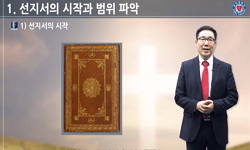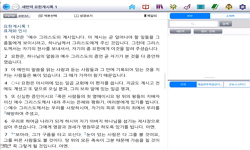The present study deals with the function and meaning of false vision in the Book of Ezekiel. The Book of Ezekiel describes Ezekiel as performing prophetic role among exiles in Babylonia. The multi cultural and polytheistic Babylonian environment gave...
http://chineseinput.net/에서 pinyin(병음)방식으로 중국어를 변환할 수 있습니다.
변환된 중국어를 복사하여 사용하시면 됩니다.
- 中文 을 입력하시려면 zhongwen을 입력하시고 space를누르시면됩니다.
- 北京 을 입력하시려면 beijing을 입력하시고 space를 누르시면 됩니다.

에스겔서에 사용된 ‘허탄한 묵시’(하존 샤브)의 의미와 기능 연구 -에스겔서 13장을 중심으로- = The Study of the Function and Meaning of False Vision in the Book of Ezekiel
한글로보기https://www.riss.kr/link?id=A104100536
-
저자
윤동녕 (서울장신대학교)
- 발행기관
- 학술지명
- 권호사항
-
발행연도
2014
-
작성언어
Korean
-
주제어
에스겔 ; 예언 ; 예언자 ; 여예언자 ; 거짓 예언자 ; 허탄 ; 묵시 ; 환상 ; 황홀경 ; 점술 ; Ezekiel ; prophecy ; prophet ; female prophet ; false prophet ; false vision ; ecstacy ; divination
-
등재정보
KCI등재
-
자료형태
학술저널
-
수록면
198-222(25쪽)
-
KCI 피인용횟수
2
- DOI식별코드
- 제공처
-
0
상세조회 -
0
다운로드
부가정보
다국어 초록 (Multilingual Abstract)
The present study deals with the function and meaning of false vision in the Book of Ezekiel. The Book of Ezekiel describes Ezekiel as performing prophetic role among exiles in Babylonia. The multi cultural and polytheistic Babylonian environment gave Ezekiel new prophetic challenge, because the Israelites exiles were being rapidly assimilated with Babylonian culture and religion. So some male prophets even in the tragic exile claimed that they saw the vision of peace, whereas the peace did not exist. In addition, some female announced prophesy out of their own imagination. They sew magic charms on all their wrists and made veils of various lengths for their heads to deceive the people. Ezekiel criticized their false prophecy by using various vocabularies, comparing them with false divination, and emphasizing uselessness of their visions.
However, Ezekiel’s prophetic authority was not completely conceded among exiles, because his prophetic channels such as dreams and visions could not simply discerned from hallucination. In fact, some Babylonian diviners also adopted dreams and visions in ecstatic state to receive divine will. So Ezekiel was required to prove the authority and authenticity of his visions. He employs a unique phrase “aw>v" !Azx]”(hazon shav) in order to support the authority of visions that he saw. For Ezekiel the phrase “aw>v" !Azx]” was the tool for arguing with false prophecy and pointing out the fallacies of new prophetic movement led by female prophets, while depending the authority of his prophecy.
국문 초록 (Abstract)
본 논문은 에스겔서에 기록된 “허탄한 묵시”의 의미와 기능을 연구한다. 에스겔은 바벨론의 포로민들에게 예언을 선포한다. 바벨론의 다문화적 다종교적 상황은 에스겔에게 새로운 예언...
본 논문은 에스겔서에 기록된 “허탄한 묵시”의 의미와 기능을 연구한다. 에스겔은 바벨론의 포로민들에게 예언을 선포한다. 바벨론의 다문화적 다종교적 상황은 에스겔에게 새로운 예언자적 역할을 기대케 한다. 왜냐하면 포로민들은 바벨론의 문화와 종교에 급속하게 동화되어 갔기 때문이다. 어떤 남성 예언자들은 포로라는 비극적 상황에도 불구하고 자신들이 보지도 못한 평강의 묵시를 선포하였다. 또한 어떤 여성들은 자신의 뜻대로 예언을 선포했다. 그들은 손목에 부적을 달고 머리에 베일을 쓰고 백성들을 속였다. 에스겔은 이들은 거짓 예언의 문제점을 지적하기 위해 다양한 용어들을 사용하고 있으며 이들 예언을 거짓 점궤와 비교하고, 또 그들이 본 묵시의 헛됨을 강조하고 있다.
그러나 포로민들은 에스겔의 예언자적 권위에 완전히 동의하지 않았다. 왜냐하면 그가 예언을 받는 수단인 꿈과 환상은 환각과 구분하기 힘들었기 때문이다. 바벨론의 점술사들의 신의 뜻을 구하기 위해 황홀경 상태에서 꿈과 환상을 사용하였다. 에스겔은 자신이 본 환상의 권위와 진실성을 증명할 필요가 있었다. 그래서 그는 “허탄한 묵시”라는 특유의 문구를 사용하여 자신이 본 환상의 권위를 변호하였다. 에스겔은 “허탄한 묵시”라는 문구를 거짓 예언과 논쟁하는 데만 사용한 것이 아니라, 여 예언자들에 의해 시도된 새로운 유형의 예언운동의 오류를 지적하고 자신의 예언의 권위를 수호하는데 사용하였다.
참고문헌 (Reference)
1 배희숙, "포로시대의 이스라엘" 크리스챤 다이제스트 2006
2 윤동녕, "신앗시리아의 왕을 향한 예언 연구" 한국신학정보연구원 5 (5): 187-215, 2011
3 윤동녕, "민수기 22-24장에 표현된 발람의 역할 연구" 한국구약학회 19 (19): 205-229, 2013
4 노세영, "고대근동의 역사와 종교" 대한기독교서회 2000
5 로버트 윌슨, "고대 이스라엘의 예언과 사회" 예찬사 1991
6 Korpel, Marjo C. A., "Ugarit, Religion and Culture: Proceedings of the International Colloquium on Ugarit, Religion and Culture, Edinburgh, July 1994. Essays Presented in Honour of Professor John C. L. Gibson" Ugaritic-Verlag 99-113, 1994
7 Stökl, Jonathan, "The mtnb’wt in Ezekiel 13 Reconsidered" 132 : 61-76, 2013
8 Jastrow, Morris, Jr., "The Religion of Babylonia and Assyria" The Atheneum Press 1898
9 Oppenheim, A. Leo, "The Interpretation of Dreams in the Ancient Near East, with a Translation of an Assyrian Dream-Book" American Philosophical Society 1956
10 Bowen, Nancy R., "The Daughters of Your People: Female Prophets in Ezekiel 13:17-23" 118 : 417-433, 1999
1 배희숙, "포로시대의 이스라엘" 크리스챤 다이제스트 2006
2 윤동녕, "신앗시리아의 왕을 향한 예언 연구" 한국신학정보연구원 5 (5): 187-215, 2011
3 윤동녕, "민수기 22-24장에 표현된 발람의 역할 연구" 한국구약학회 19 (19): 205-229, 2013
4 노세영, "고대근동의 역사와 종교" 대한기독교서회 2000
5 로버트 윌슨, "고대 이스라엘의 예언과 사회" 예찬사 1991
6 Korpel, Marjo C. A., "Ugarit, Religion and Culture: Proceedings of the International Colloquium on Ugarit, Religion and Culture, Edinburgh, July 1994. Essays Presented in Honour of Professor John C. L. Gibson" Ugaritic-Verlag 99-113, 1994
7 Stökl, Jonathan, "The mtnb’wt in Ezekiel 13 Reconsidered" 132 : 61-76, 2013
8 Jastrow, Morris, Jr., "The Religion of Babylonia and Assyria" The Atheneum Press 1898
9 Oppenheim, A. Leo, "The Interpretation of Dreams in the Ancient Near East, with a Translation of an Assyrian Dream-Book" American Philosophical Society 1956
10 Bowen, Nancy R., "The Daughters of Your People: Female Prophets in Ezekiel 13:17-23" 118 : 417-433, 1999
11 Darr, Katheryn Pfisterer, "The Book of Ezekiel: Introduction, Commentary, and Reflection" 6 : 1073-1607,
12 Block, Daniel I., "The Book of Ezekiel: Chapters 1-24" Eerdmans 1997
13 Davies, Graham I., "Scripture and Other Artifacts: Essays on the Bible Archaeology in Honor of Philip J. King" Westminster John Knox Press 108-125, 1994
14 "Reiterer, F. V., “aw>v””, TDOT 14, 447-460"
15 Nissinen, Martti, "References to Prophecy in Neo-Assyrian Sources"
16 Weippert, Manfred, "Prophetie und Psalmen: Festschrift für Klaus Seybold zum 65 Geburtstag" Ugarit-Verlag 31-59, 2001
17 Levison, John R., "Prophecy in Ancient Israel: The Case of the Ecstatic Elders" 65 : 503-521, 2003
18 Kitz, A. M., "Prophecy as Divination" 65 : 22-42, 2003
19 Oden, Robert A. Jr, "Myth, Mythology: Myth in the OT" 4 : 946-960,
20 Friebel, Kelvin G., "Jeremiah’s and Ezekiel’s Sign-Acts: Rhetorical Nonverbal Communication" Sheffield Academic Press 1999
21 Pongratz-Leisten, Beate, "Herrschaftswissen in Mesopotamien: Formen der Kommunikation zwischen Gott und K nig im 2. und 1. Jahrtausend v. Chr" The Neo-Assyrian Text Corpus Project 1999
22 Jost, Renate, "Für Gerechtigkeit streiten: Theologie im Alltag einer bedrohten Welt. Für Luise Schottroff zum 60" Kaiser 59-65, 1994
23 Jost, Renate, "Feminist Biblical Interpretation: A Compendium of Critical Commentary on the Books of the Bible and Related Literature" Eerdmans 345-360, 2012
24 Crouch. C. L., "Ezekiel’s Oracles against the Nations in Light of a Royal Ideology of Warfare" 130 : 473-492, 2011
25 Patton, Corrine L., "Ezekiel’s Hierarchical World: Wrestling with a Tired Reality" Brill 73-89, 2004
26 Lind, Millard, "Ezekiel: Believers Church Bible Commentary" Herald Press 1996
27 Zimmerli, Walther, "Ezekiel: A Commentary on the Book of the Prophet Ezekiel" Fortress 1979
28 Mays, James Luther, "Ezekiel, Second Isaiah" Fortress Press 1978
29 Boadt, Lawrence, "Ezekiel, Book of" 2 : 711-722,
30 Eichrodt, Walther, "Ezekiel : A Commentary" Westminster 1970
31 Allen, Leslie C, "Ezekiel 1-19" Word 1994
32 Duguid, Iain M., "Ezekiel & the Leaders of Israel" Brill 1994
33 Odell, Margaret S., "Ezekiel" Smyth & Helwys Publishing 2005
34 Herrmann, J., "Ezechiel" A. Deichert 1924
35 Ewald, Heinrich, "Die Propheten des alten Bundes" Adolph Krabbe 1840
36 Gafney, Wilda, "Daughters of Miriam: Women Prophets in Ancient Israel" Fortress 2008
37 Nissinen, Martti, "Changing Face of Form Criticism for the Twenty-First Century" Eerdmans 122-161, 2003
38 Fales, F. M., "Census, Ancient Near East" 1 : 882-883,
39 Scurloc, J. A., "Baby-snatching Demons, Restless Souls and the Dangers of Childbirth: Medico-Magical Means of Dealing with Some of the Perils of Motherhood in Ancient Mesopotamia" 2 : 135-183, 1991
40 Oppenheim, A. Leo, "Ancient Mesopotamia : Portrait of a Dead Civilization" Chicago University Press 1964
동일학술지(권/호) 다른 논문
-
- 한국구약학회
- 유종근
- 2014
- KCI등재
-
- 한국구약학회
- 한동구
- 2014
- KCI등재
-
요나의 기도(욘 1:17-2:10)에 묘사된 요나의 성격 이해
- 한국구약학회
- 김상래
- 2014
- KCI등재
-
- 한국구약학회
- 김희성
- 2014
- KCI등재
분석정보
인용정보 인용지수 설명보기
학술지 이력
| 연월일 | 이력구분 | 이력상세 | 등재구분 |
|---|---|---|---|
| 2026 | 평가예정 | 재인증평가 신청대상 (재인증) | |
| 2020-01-01 | 평가 | 등재학술지 유지 (재인증) |  |
| 2017-04-20 | 학술지명변경 | 외국어명 : Journal of Korean Old Testament Society -> Korean Journal of Old Testament Studies |  |
| 2017-03-17 | 학회명변경 | 영문명 : Korean Old Testament Society -> Korean Society of Old Testament Studies |  |
| 2017-01-01 | 평가 | 등재학술지 유지 (계속평가) |  |
| 2013-01-01 | 평가 | 등재 1차 FAIL (등재유지) |  |
| 2010-01-01 | 평가 | 등재학술지 선정 (등재후보2차) |  |
| 2009-01-01 | 평가 | 등재후보 1차 PASS (등재후보1차) |  |
| 2007-01-01 | 평가 | 등재후보학술지 선정 (신규평가) |  |
학술지 인용정보
| 기준연도 | WOS-KCI 통합IF(2년) | KCIF(2년) | KCIF(3년) |
|---|---|---|---|
| 2016 | 0.72 | 0.72 | 0.67 |
| KCIF(4년) | KCIF(5년) | 중심성지수(3년) | 즉시성지수 |
| 0.62 | 0.58 | 0.788 | 0.24 |




 KCI
KCI DBpia
DBpia






